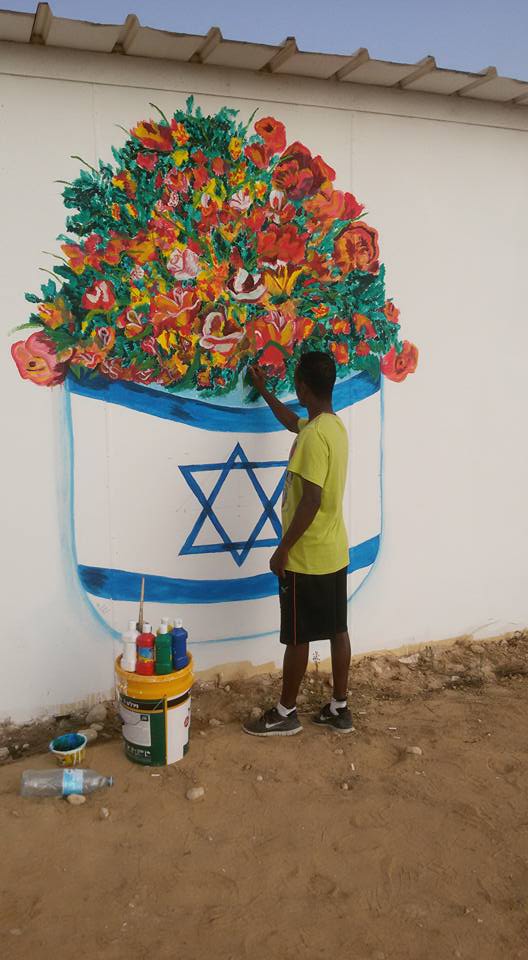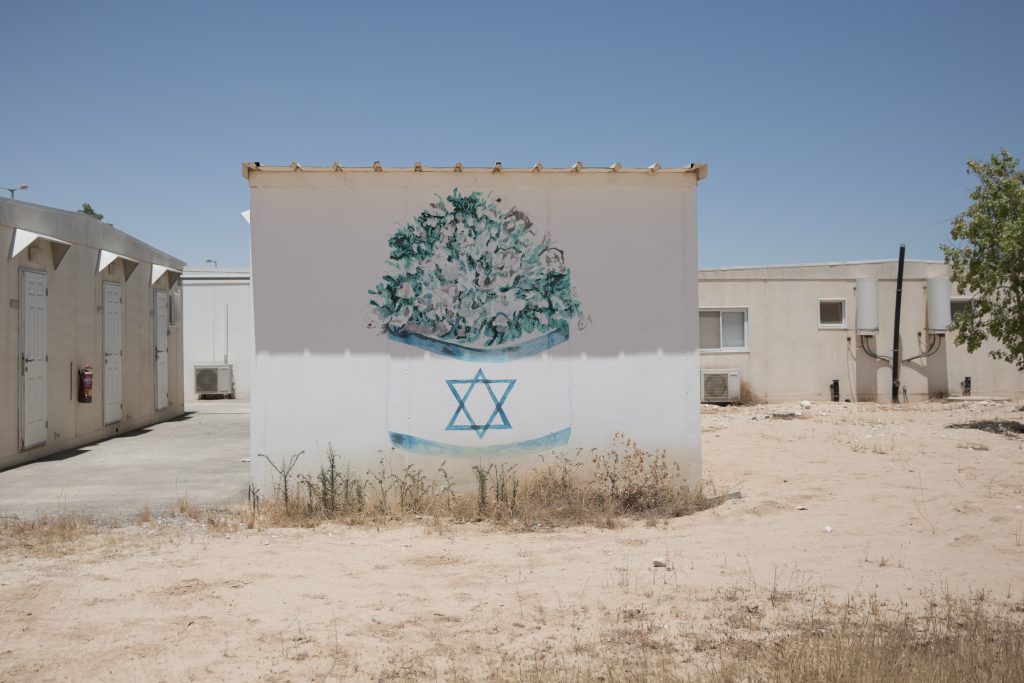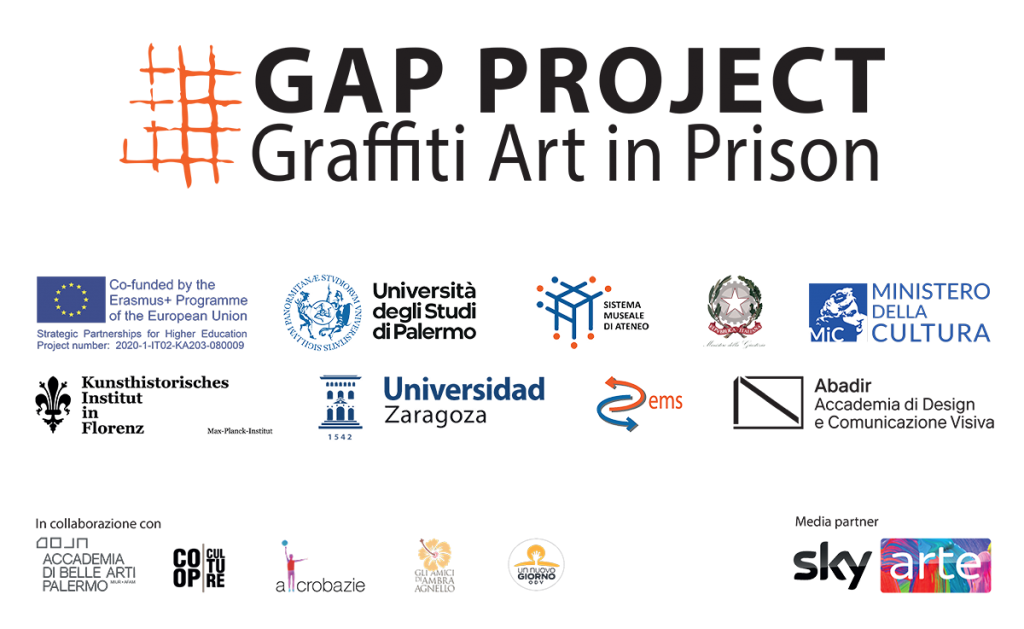Hamutal Sadan
Graffiti art made in prisons raises questions of censorship and propaganda. What are the detainees allowed or ordered to paint? In this post, I would like to present the case of graffiti art made by asylum seekers in the Holot detention center in Israel, which operated between 2013 and 2018. I will focus on a painting made by Tsegay Berhe, an asylum seeker from Eritrea, who was detained in Holot between 2015 and 2016.
Holot detention center was opened in 2013 in the middle of the Negev desert in the South of Israel, and incarcerated asylum-seeking men from Eritrea and Sudan who arrived in Israel to ask for refuge. The former Interior Minister of Israel, Eli Yishai, stated he was opening the detention center because until he can deport the asylum seekers, he «will imprison them and make their lives unbearable», so they will leave Israel «voluntarily». Holot, which was ran by the Israeli Prison Services, was finally closed in 2018 after several decrees by the Supreme Court, ordering the improvement of the conditions in the detention center and the shortening of the stay of the detainees.
Tsegay Berhe is an asylum seeker who arrived in Israel from Eritrea in 2010, after fleeing a lifetime of service and the dictatorship regime in his homeland. In 2015 he was incarcerated in Holot for a year. As a self-taught artist, he wanted to spend the long days in detention painting, and thus asked for permission to paint on the walls of the inmates’ salon room, where he painted dozens of graffiti art paintings (mostly free animals in nature and Eritrean familial life). After seeing the head of the wing’s appreciation of his talent, he asked if he can be paid for decorating the facility’s walls. The head of the wing granted him permission to paint on the exterior walls of the facility in exchange for some pocket money. He ordered the prisoners not to paint “a lion in a cage”, as it was seen as a criticism of the incarceration of the asylum seekers in detention – a demand which can see as censorship. He asked Berhe to paint the flag of the State of Israel, as much as the emblems of the Israeli State, the Israeli Prison Services, and the Immigration Authority – which can be seen as propaganda to those authorities. Berhe was not the only detainee to paint on the interior walls of Holot, and I know of at least one other artist – Afwerki Teame – who was paid pocket money for his work. The censorship was enforced on all, but as far as I know, only Berhe was asked to paint those emblems on the exterior walls of the facilities. Most of the paintings could be found on the interior walls (like in the salon and the hairdressing rooms).

In this post, I would like to focus on the painting of the Israeli flag. The flag of Israel was adopted on 28 October 1948, five months after the establishment of the State of Israel. It depicts a blue hexagram on a white background, between two horizontal blue stripes. The basic design recalls the Tallit (טַלִּית), the Jewish prayer shawl, which is white with black or blue stripes. The symbol in the center represents the Star of David (Magen David, מָגֵן דָּוִד), a Jewish symbol. When Berhe agreed to paint this emblem, he did not know its religious, Zionist, and historical meanings. He saw the shape and colors from an aesthetical point of view, thinking the blue-and-white colors of the flag were beautiful and symbolized peace. But he felt the current shape misses something. He used his smartphone to google pictures of the flag and found one where it was seen on a mug. He liked the curved shape of the flag as a mug and decided to paint the flag as a vase, to which he added a bouquet of colorful flowers. As it was not allowed to enter colors and artistic materials into the detention center, Berhe used colors brought by the art therapist who conducted workshops in Holot on behalf of the Prison Services (fig. 1).
The act of painting the flag – a national emblem – as a receptacle, can be seen as a deconstruction of its symbolic historical, national, and religious meaning. The deconstruction and recreation of the flag give it a new meaning. I will propose hereinafter an interpretation of its new meaning.
Following the Second World War and the Holocaust, the flag has been symbolizing in the Israeli consciousness the purpose of the State of Israel as a home and shelter for every Jewish person. As a State built by refugees – survivors of the Holocaust – Israel is in a moral conflict: on the one hand, many people see their history as a constant reminder of the responsibility of the Jewish people towards other non-Jewish refugees, for «we were all once refugees» as the famous saying. On the other hand, many see Israel as a home solely for the Jewish people as it is often said: «We do not have any other country».
The painting of the flag of Israel was first photographed by Berhe himself in 2016, when the colors were strong and bright (fig. 2); and then again in 2018 by a professional photographer, after Holot was closed, when the colors had already become faded in the desert sun (fig. 3). I suggest a metaphorical interpretation of the difference between these two versions.

(photo: artist)

(photo: Miriam Alster, 2018)
The painting signifies the asylum seekers’ hope to find shelter in Israel, to be protected by the State, which will function as a source of life and hope. Thus, the vase with the flag refers to the State of Israel, and the flowers – which are varied in their colors and shapes – are a simile to the asylum seekers. When flowers are cut from their roots and put in a vase, they will wither after a while. In a similar way, the asylum seekers arriving in Israel, if they are not given rights and permanent status, they are not able to put down roots, to build a future and a home in the country. Following that, many of them become desperate and leave Israel for third countries, as the former Minister of Interior intended. Indeed, all the hope that was expressed by the vivid colors in the original painting from 2016, faded away in the Israeli desert sun. Israel, as the State of Jewish refugees, was supposed to assist the African asylum seekers, yet it only agrees to temporally protect them from deportation, not giving them any permanent status, and actively attempts to make them miserable (e.g., detaining them in Holot), so that they will be compelled to leave.
To conclude, the irony of the situation does not escape us: an asylum seeker who arrives in a host country to seek refuge is put in detention in order to make him feel miserable and to encourage him to leave the country “voluntarily”, as he cannot be deported. In the detention center, he is requested to paint the emblems of the State that imprisons him on the walls of the facility. Nevertheless, even under such restrictions, one can see signs of resistance and agency. While the theme for the painting was ordered from above, Berhe chose to deconstruct the emblem from its historical and national meanings and recreate it in his own style and thus opening new ways to interpret the painting and make it his own.
In this liminal and heterotopian place, where asylum seekers were thrown outside of the sight and heart of the Israeli society into the desert, some of them fell into despair and decided to leave “voluntarily” to Rwanda or Uganda, in order to search for better lives. But some others managed to find the strength inside them and use the long hours as an opportunity to create art. According to Berhe, the purpose of most of his paintings in Holot was to make the other detainees feel calm and happy. This purpose can also be seen as an act of resistance to the former Minister of Interior’s goal to make the lives of asylum seekers unbearable. By creating art in Holot, not only did Berhe add beauty to the naked walls of the facility in the heart of the wilderness, but he also gave hope and serenity to his detainee friends, thus helping them to handle their despair and preventing them from putting their lives in danger and leaving to a second journey of refuge.
References
Omry Efraim, Eli Yishai: «I Ordered the Arrest of Eritreans and Sudanese. I Will Make Their Lives Unbearable» (אלי ישי: הוריתי על מעצר אריתריאים וסודנים, ‘אמאיס עליהם את חייהם), YNET, August 16, 2012, https://www.ynet.co.il/articles/0,7340,L-4269527,00.html.
Kim Skjoldager-Nielsen, Joshua Edelman, Liminality, Ecumenica 7, nos. 1–2 (2014).
Victor Turner, The Forest of Symbols: Aspects of Ndembu Ritual, New York City 1967.
Arnold van Gennep, The Rites of Passage, trans. Monika Vizedom and Gabrielle Caffee, Chicago 2019.
Michel Foucault, Of Other Spaces: Utopias and Heterotopias, in Architecture /Mouvement/ Continuité, n. 5 (1984).

